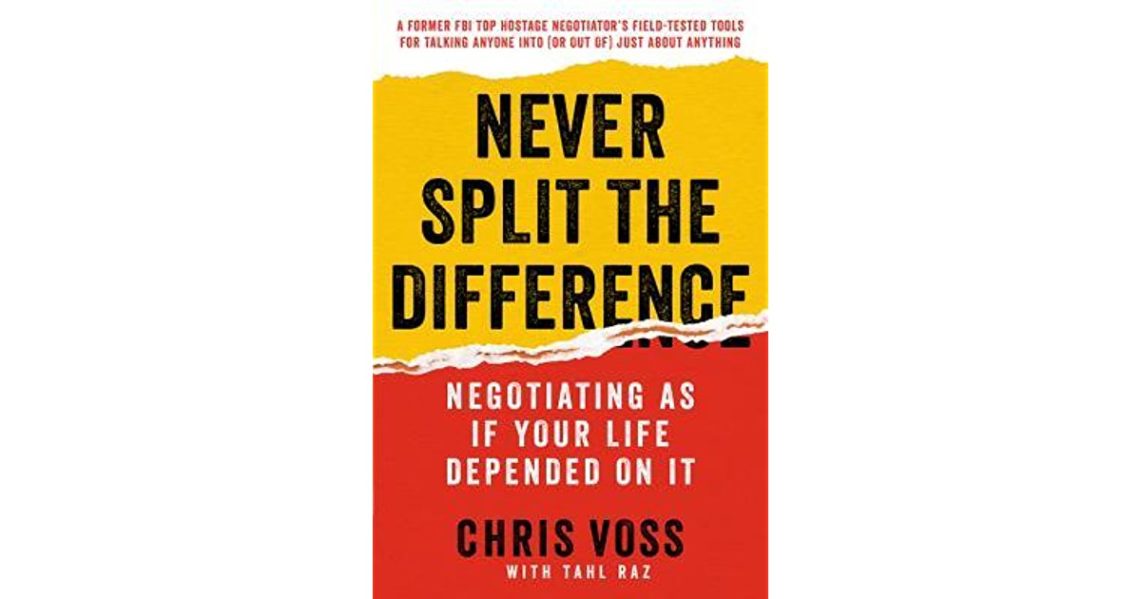
Never Split the Difference Review
Never Split the Difference: Negotiating As If Your Life Depended On It by Chris Voss is a fascinating look at hostage negotiation techniques with useful tips and tricks to improve your own personal negotiations. Don’t think you have any?
Do you have a child that won’t go to bed? Do you need to make a large purchase and need to negotiate the price?
Plus, it’s amazing how much more confident you feel in life when you feel you can handle what comes at you.
What Never Split the Difference Is About
The author Chris Voss was a hostage negotiator who worked at the FBI and now teaches negotiation skills.
His premise is that there are times when you cannot split the difference when negotiating. You couldn’t say, “Ok, release half the hostages, and we’ll call it a day.” When you’re a hostage negotiator, you have to win at all costs.
A successful negotiator in all things uses active listening, smart silence and tactical empathy to build trust and have a better understanding of the situation.
But What About Yes?
The author also discusses why Getting to Yes philosophy is the wrong way to go. Negotiation starts when your opponent says “no.”
Chris built his career in the FBI, and then wanted to get on the special Crisis Negotiation Team. He was kicked out of the office after he asked, but the head of the team told him to go volunteer at a suicide hotline if he wanted to get good experience. There was a funny story that I won’t ruin for you about how well he did (or didn’t) do.
Because he took the advice, he was added to the team. This is also a good lesson about following mentor’s recommendations which was also discussed in Lean In.
Mirroring
Mirroring is repeating the critical one to three words of what someone has just said, and then staying quiet to give the other person time to speak.
Often, you’ll first say “Sorry…” and then repeat the phrase. This allows the other person to pause and think about what they just said.
Chris Voss had a wonderful example of how a student of his was able to manage her boss who was notorious for running in, making demands, increasing stress, and then running out.
Using mirroring, the student was able to slow down the conversation so that way the boss could think about his request and what it was he really needed. I’m planning on using this the next time someone tries to ask me quick questions to get me to react instead of respond.
 Neutralize the Negative
Neutralize the Negative
If you can spot an emotion and label it, you’ll also build trust. However, you have to be conscious of how you’re labeling it.
Use sentence starters like “It seems like…” or “It sounds like …” or “It looks like….” You will want to avoid saying “I’m hearing that…” because you don’t want to be in the sentence.
Your counterpart may perceive you as being judgmental of them. And you want to keep your ego far out of the conversation.
You’re There to Learn
But just pointing out something neutrally will give you a chance to refine how they’re feeling. If they disagree strongly, you can always step back saying “I didn’t say that was what it was. I just said it seems like that.”
The next step after labeling is silence. You want to give the other person a chance to confirm or refine what you just said.
When you label something that could be negative, you neutralize it. That allows it to be discussed.
For example, if your child is acting out, you could try labeling it as “It seems as though you’re bored here.” Your child knows their behavior isn’t good, and by identifying it, you’ve opened the door to discuss how they really feel.
Be Open About the Negative
If you have bad news to deliver, be up front that it’s bad because then the other person will be more open to listening.
Part of the key of this book is learning how to give a feeling of control to your counterpart so they are engaged in the negotiation, and want to be part of finding a mutually beneficial solution.
 Getting to No
Getting to No
When your counterpart says no, it helps them feel like they’re more in control of the situation.
Again, often with negotiation, it’s not so much what’s really happening but the perception of what is happening. As humans we have a deep need for feeling like we’re directing our own lives.
When someone says “No,” that tells you the real negotiation is about to begin.
This also means you have to learn how to say “No” confidently and calmly. This isn’t easy for women because we’re inherently wanting to please others.
No Is A Good Thing
What “No” really means is:
- I’m not yet ready to agree
- You are making me feel uncomfortable
- I do not understand
- You’re not giving me enough information
- It’s too expensive
- I want to talk to someone else
So when you hear “No,” you will want to pause and then ask some open-ended questions to get the dialog going. You could ask “What about this doesn’t work for you?”
Or you could just make a statement of fact like “It seems like there’s something here that bothers you.”
Eventually, you will want to get to a “Yes” of some sort to have agreement. But if you go for “Yes” too soon, people will suspect you’re trying to sell them something.
Calibrated Questions
When you can turn the conversation around by asking “How,” you’ll be able to get your counterpart to bid against themselves. And you’ll uncover hidden agendas.
You’re giving your counterpart the power, or so they think. It allows them to either come up with a solution that you can then negotiate. Or you can get them to answer that they don’t know to which you can counter that you don’t know how to achieve their desire either.
The Real Answer You Want
You don’t want them to say “Yes” right away. First you want them to say “That’s right.”
A quick yes is often just a way of agreement or to move the conversation along. But there’s no commitment from the other person to actually do something.
When they say “That’s right,” it’s like a magical key opening up a hidden door. Suddenly they’re seeing what you hoped they would see. They’re feeling heard and understood.
Avoid “You’re Right”
When someone says “you’re right,” They’re just trying to shut you up and get you to leave them alone. I hate to put it so bluntly. However it’s a very effective tactic to end an argument that you don’t want to be in by just telling the other person that they’re right.
And it’s also the wrong way to handle a negotiation.
 Uncovering the Important Information
Uncovering the Important Information
In every negotiation, there are between three and five pieces of information that, if they’re uncovered, would change everything. Chris Voss calls these the Black Swans of negotiation because a black swan is a very rare bird.
Often, by listening and asking questions, you can uncover hidden motivations or useful bits of information that can help you close the deal. The author had a great example about a gentleman who needed his boss’ permission to transfer to a different area in the company. With the additional information, the gentleman was able to get everything he needed and be able to help his former boss as well.
My Final Thoughts
I loved how Chris Voss said that a good negotiator prepares to be ready for the unexpected and a great negotiator uses her skills to reveal the surprises she is certain to find. The key is to stay focused on the other person throughout. You use empathy to understand.
Empathy doesn’t mean you accept the other person’s feelings. It means that you understand that their feelings are true for them. Your goal is to uncover as much information as possible.
It’s useful to let the other party feel like they have the illusion of control. You can then use that to learn more about their motivations and other hidden agendas.
And never be afraid to walk away from a bad negotiation.
These skills will help you feel more confident and truly be more in control of your own life.
You can find Never Split the Difference at your local bookstore. If you’ve read it, please leave a comment with your thoughts.




